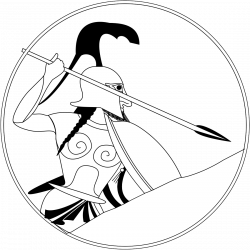Many greetings; welcome to Warriors on the Periphery!
An Introduction
This is a weblog linked to the project of the same name, currently ongoing in the Université Libre de Bruxelles. It is meant to host regular updates and progress reports regarding the project. My hope is that it will increase project visibility (for both academic and non-academic audiences) and allow for some degree of feedback from other interested scholars.
Warriors on the Periphery is a post-doctoral project, funded by the Philippe Wiener – Maurice Anspach Foundation and hosted by the ULB (specifically the Centre de Recherches en Archéologie et Patrimoine / CReA-Patrimoine). My most sincere thanks and gratitude go to the above institutions for their kind and invaluable support.
The Project
Warriors on the Periphery is an archaeological project, focusing primarily on the study of ancient arms and armour. It brings new material to the fore, but also seeks to touch upon three major topics that have received considerable scholarly attention in the past:
Firstly, it is meant to provide an additional (or, perhaps, an expanded) perspective on matters of Ancient Greek warfare and, specifically, the changes that take place during the Iron Age – Archaic period transition. The so-called ‘hoplite discussion’ has occupied scholars for more than a century. Of course, I do not presume to end it; but I do hope to provide some new insight on how military armament and doctrine evolves during this period. The important thing to note is that this project focuses not on the central, ‘core’ Greek regions (that have featured extensively on previous scholarship) but on a ‘peripheral’ Aegean region: that of the Gulf of Kavala.
The Gulf of Kavala and the island of Thasos
This region was selected for this study because it features prominently in discussions regarding Greek ‘Colonisation’ during the 7th and 6th centuries BCE. Originally inhabited by non-Greek, ‘Thracian’ populations, the region is gradually settled by Greek apoikoi – first the island of Thasos and then the mainland coast. The first indications of newly established, organised settlements along the Greek paradigms in the region can be dated to around 675-650 BCE. Therefore, the second major narrative that this study aims to contribute to is that of the nature of the interactions between local populations and Greek settlers, as they are reflected in weaponry. I wish to investigate whether these interactions included martial conflict between Greeks and Thracians; and to what extent Greek martial paradigms superseded, coexisted with, and/or were abandoned in favour of local weaponry and tactics.
A third, and final point involves matters of social development, status and roles; and the social function of weaponry, within the context of the developing poleis city-states of the Kavala Gulf. As the social structure of the local communities changes, so too does the way that warriors are perceived, both by members of their own social group and by the community as a whole. My aim is to ascertain whether new warrior ‘identities’ make their appearance in the developing poleis – colonies of the Kavala Gulf; to establish whether such identities differ markedly from what characterises the pre-colonial communities; and to determine the extent to which they contributed to the forming of Archaic political thought.
The Blog
During the upcoming months, this weblog will be updated with short reports regarding my dataset and my research progress. I will also include brief, pre-publication analyses and descriptions of the finds as well as discussion on theory and interpretation. I heartily welcome comments and criticism and will seek to respond where appropriate.
Please keep in mind that this project is ongoing and that any early conclusions posted here may subsequently prove to be erroneous. This is not meant to be an electronic publication; think of it more as a journal, meant to help me organise my thoughts while also discussing the research involved

